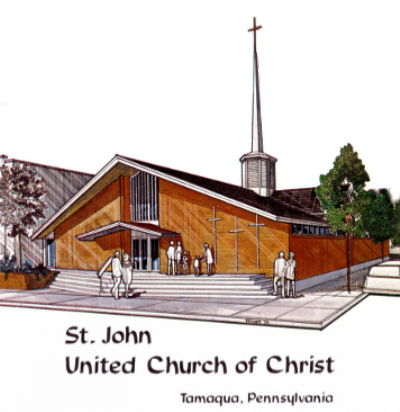In 1855, a second church building was built in the "Dutch Hill" area to accommodate the growing congregation. This was a larger brick building with a Sunday school on the first floor and the sanctuary occupying the upstairs. This church also served as the joint home to both Lutheran and Reformed congregations, each worshipping on alternating Sundays. Services were only conducted in the German language until July of 1865 when English language services were first introduced.
In 1867, members of the Reformed congregation would split and form our sister church, Trinity UCC in Tamaqua. In 1883, the Reformed and Lutheran congregations separated, and the Reformed congregation began construction of a church on Pine Street at our current location. The original church building on Pine Street would be completed in 1884. This building would be renovated in 1908 and expanded to accommodate a larger congregation and Sunday school. Ground would be broken in 1959 for our Christian Education building which currently houses our Fellowship Hall, offices, and Sunday school classrooms. This building would be completed in 1960 and stands next to our main church building.
Our present church building would be built in 1973. This building was designed by the architectural firm of Heyl-Treby-Howard-Philips of Allentown, with Mr. John Philips of the staff responsible for the design of the building. Harold Blacker, Inc., of Wescoesville was the general contractor.
The exterior of the building is designed to resemble an ark, which is the symbol for the church. The spire on the center of the building, directly above the altar rises 48 feet from the roof, and contains the bell of the original building which has been electrified and can be rung automatically at any hour of the day as well as tolled. A ramp on the Railroad Street end of the building, leading directly from Biddle Street, allows persons to enter the church without climbing any steps.
The interior of the church has been designed in a semi-round arrangement, and is one of the few times this arrangement has been used in a rectangular building. The church has always been thought of as the "Family of God" and the arrangement of the altar in the center of the nave, with the people gathered around it, emphasizes this "family" concept.
The location of the altar and pulpit emphasizes the Reformed concept of worship: namely, that worship is primarily a service of both Word and Sacrament. The central position of the altar and pulpit bears witness to this fact. The central position of the pulpit also emphasizes the importance of preaching in the Reformed tradition of worship. The baptismal font has been made a part of the altar to symbolize the two sacraments of the Protestant Church: Baptism and Holy Communion. The altar has been designed to be used on all four sides, and allows all the liturgical action to be performed in the midst of the congregation.
The windows were designed for the church by the Willet Studios of Philadelphia. The windows tell the story of the life of Jesus Christ. The large west window (Railroad St.) begins the story with the Nativity, or the birth of Christ. Included in the window are Mary, Joseph, the Christ child, the Wise Men, the shepherds and the animals.
The ribbon windows continue the Gospel record and although they are not in chronological order, each group of three has a definite theme.
Beginning at the west (Railroad St.) end of the building, the first group of three depict the beginning of Jesus' ministry.
The three show:
1. Jesus, the boy of 12, in the Temple surrounded by the scholars.
2. Jesus' baptism in the River Jordan by John.
3. Jesus calling the fishermen to leave their nets and follow him.
The theme of the next group of three panels is Jesus' teaching.
1. The parable of the Good Samaritan.
2. Jesus setting a child in the midst of the disciples arguing about who should be the greatest.
3. The parable of the Sower.
The next group of panels show three of Jesus' miracles.
1. The Wedding feast at Cana where Jesus turned the water Into wine.
2. Feeding of the five thousand.
3. Stilling the storm at sea.
The ribbon windows are interrupted by the two larger windows over the choir. On the left is the crucifixion of Christ. He hangs on the cross flanked by the sun and the moon.
Standing nearby is the beloved disciple John supporting Jesus' mother, Mary, who has just been commended into his care by Jesus. At the shorter end of the window is a symbol of a fish impaled on the anchor cross. The fish has been associated with Christianity even before the cross. As the anchor is a symbol of hope, this symbolizes the fact that Christ's death on the cross for the sins of the world gives hope to those who believe in Him.
The choir window on the right shows Jesus Christ emerging from the empty tomb bearing aloft the banner of victory of life over sin and death. In the adjoining panel is one of the Centurion guards recoiling in amazement when the stone is rolled away. The phoenix is used as a symbol of the resurrection. The ancients thought this mythical bird, instead of dying when old, set fire to its nest and rose rejuvenated from the flames.
The ribbon resumes with three panels which emphasize that Jesus is the Christ, Son of God.
1. Jesus speaking to the Samaritan woman at the well, who returned to the city and proclaimed him the Messiah.
2. The Transfiguration where Jesus appeared to Peter, James and John, flanked by Moses and Elijah.
3. Jesus giving keys to Peter after Peter told him he was "the Christ, the Son of the Living God.
The next group of panels show three of Jesus' miracles of healing.
1. Healing of the ten lepers, and only one stops to thank Him.
2. Jesus anointing the eyes of the blind man with clay to restore sight.
3. Jesus brings his friend Lazarus back to life again.
The last group of panels show scenes of Jesus' intimate ministry, when He found occasion to speak with one or two people.
1. Jesus speaking with Nicodemus who came by night.
2. Jesus blessing the children that his disciples tried to turn away.
3. Jesus talking to Mary, while Martha prepares the meal.
The large window on the east (Pine St.) wall shows the Great Commission. Here Jesus sends his disciples out into the then-known world, instructing them to "go into all the world…and teach all nations, baptizing them in the name of the Father, and of the Son, and of the Holy Spirit". This is symbolized by the open book superimposed on the globe of the world and scallop shell of Baptism with three drops of water.
The small window on the east wall of the narthex contains the symbols of St. John and is the "signature" of this parish. This church is dedicated to John who is known as the "beloved disciple." The symbol of John is an eagle, since his gospel is considered to be the most inspirational, equating his flights of inspiration with the soaring eagle which, in the window, holds an open book. The fish is an early Christian symbol used even before the cross. The Greek word for fish - Icthus - is a rebus: Jesus Christ, Son of God, Savior. The symbol below is a chalice from which a serpent crawls. This refers to an attempt on the saint's life by his enemies who poisoned the communion wine in the chalice. But, supposedly, he was saved from death by the miracle of the poison crawling from the cup in the form of a snake.
The organ is basically the pipe organ installed in the original building in 1930 but completely rebuilt by the Fritszche Organ Co. of Allentown. They have used all the original pipes, in addition to adding a new rank of 61 pipes, and have built all new wind chests and provided a new console.
The suspended cross hanging above the altar was made by one of our own members - Mr. Daniel Geissinger - who also designed and made the processional cross. Included in the cross is the eternal light which will burn continuously to symbolize the fact that "the Lord is in His holy temple."
The following is a list of the ministers who have served the congregation of St. John:
Rev. Hassinger 1835-1845
Rev. Robert Van Court 1853-1857
Rev. Levi K. Derr 1858-1866
Rev. Julius Kurtz 1867-1874
Rev. P. Adam Swartz 1874-1876
Rev. Isaac E. Graeff 1879-1888
Rev. Hiram A. Frantz 1889-1899
Rev. Albert Lobach 1900-1911
Rev. Jesse M. Mengel 1911-1917
Rev. J. Arthur Schaeffer 1917-1943
Rev. Arthur D. Knoebel 1944-1957
Rev. Paul B. Kendall 1957-1961
Rev. Milton E. Detterline Jr. 1961-1969
Rev. Clarence R. Funk 1969-1978
Rev. John L. Gilmore 1979-1981
Rev. Kenneth E. Yearick 1983-1995
Rev. James A. Greaser 1999-2002
Rev. Kevin Duffy-Guy 2003-Present
Sons and Daughters of the Congregation
Rev. Samuel E. Lobach
Rev. Rocye E. Schaeffer
Rev. Marlin T. Schaeffer
Rev. Joseph M. Steinert
Rev. John A. Yarborough
Rev. Paul H. Sherry
Joan Kacik Hamilton
Rev. David H. Knoebel
Rev. Brad S. Lutz
Rev. Gary Rarick
Rev. Glenn Rarick


